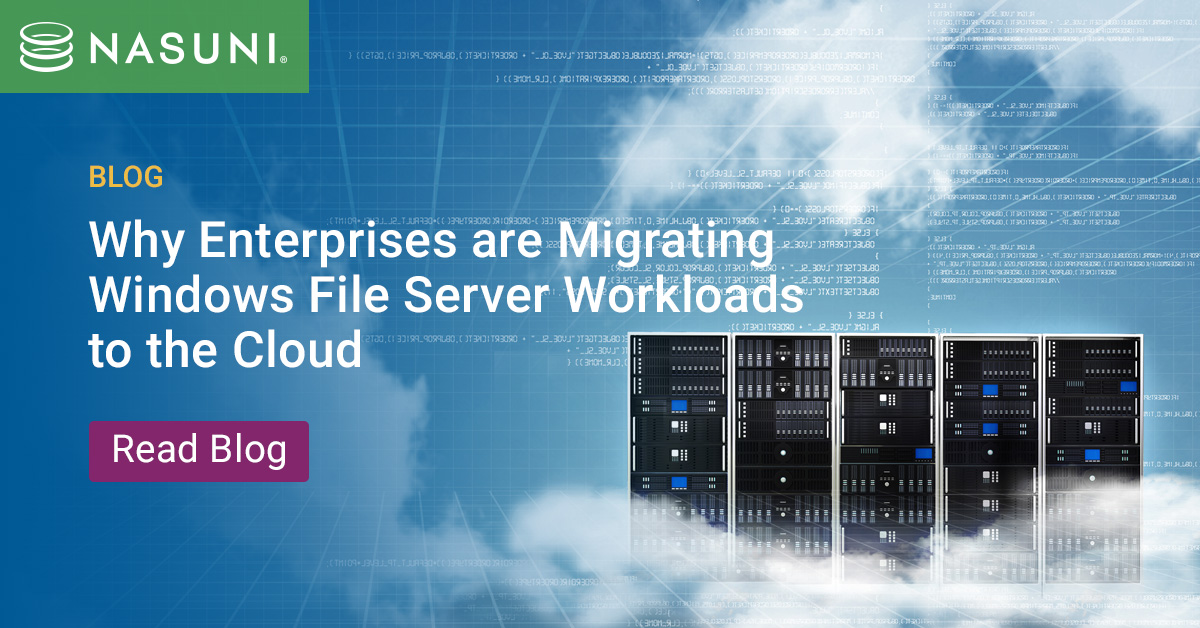Why Enterprises are Migrating Windows File Server Workloads to the Cloud
September 10, 2020 | Anne Blanchard
More and more large enterprises are migrating file storage to the cloud to eliminate the hassle and reduce the costs of managing data. Technology author and Microsoft MVP Brien Posey has written a new white paper on the topic, focused specifically on large organizations migrating Windows File Server workloads to Azure. Posey examines the different solutions enterprises have chosen to underpin their new cloud infrastructure, including Azure Files, Azure NetApp Files, and Azure Blob storage and Nasuni. In this post, though, I’d like to highlight his findings on the 6 reasons enterprises are migrating Windows File Server workloads to the Azure cloud in the first place.
- Windows Server 2008 End-of-Life
The first and more obvious reason is the January 2020 end-of-life date for Windows Server 2008 and 2008 R2. Posey notes that although the hardware continues to function, Microsoft only provides regular security updates for a price – and that cost can be prohibitive. Transitioning to Azure allows these organizations to maintain – and in some cases expand – functionality and performance without driving up costs.
- The Shift to Remote Work
Another driver behind these enterprise migrations off Windows Server is the pandemic-driven shift to remote work environments. Enterprise IT had to find ways to support a suddenly remote workforce, and many companies addressed the challenge by migrating files and critical business workloads to Azure or other public clouds.
- Stronger Security & Permissions Controls
Posey explains that Azure-based file services appeals to IT because it gives them a level of oversight and control that isn’t possible with consumer-oriented file sharing services such as Dropbox. Data placed in Dropbox is stored outside IT’s control. Conversely, files can be stored in Azure in such a way that the enterprise security perimeter is effectively extended to the cloud. Instead of sacrificing security, IT can ensure proper protection while delivering the same file sharing functionality afforded by consumer file sharing solutions.
- File Data Growth
The other massively influential driver behind these migrations is file data growth. At many large enterprises, file data is growing steadily and unpredictably. Estimating capacity needs with any accuracy is nearly impossible, and enterprises either purchase too much hardware or too little. Neither scenario benefits the enterprise, so companies are opting instead for the flexible, pay-as-you-go pricing offered by Azure. This way, enterprises never risk overpaying for storage. They pay for what they use.
- Cost-Conscious Planning
Detractors will argue that the public cloud is no longer the inexpensive alternative to on-premises operations that it was in its early days. Cloud economics can be complex, and enterprises that rush into migrations can experience sticker shock upon seeing their first bill.
As Posey notes in the white paper, there is no guarantee that migrating data to the cloud will reduce your costs. But if done correctly, with a solution that dedupes and compresses data, leverages less expensive tiers, and minimizes egress charges, organizations can save as much as 50% or more.
The cloud model also turns file storage costs into predictable operating expenditures spread out over many years instead of a series of random, and often unexpectedly large, large CapEx payments. This has proven especially attractive to enterprises in 2020, given the uncertain economy.
- Centralization vs. Data Silos
Finally, migrating enterprise file data to Azure eliminates the data silos that plague so many corporate IT departments. Instead of residing on islands of hardware spread across dozens or even hundreds of global offices, file data resides in one place – Azure.
Three Popular Microsoft Azure Solutions
In the final section of the paper – maybe the most interesting – Posey details the three most popular options for enterprises migrating their Windows File Servers to Azure cloud. He analyzes each one, including Azure Files, Azure NetApp Files, and Azure Blob storage and Nasuni, in terms of architecture, scalability, performance, and cost, and looks at some of the technical specifics of each implementation.
The scalability factor is particularly interesting – the fact that a solution leverages the unlimited Azure cloud does not actually mean the solution itself delivers unlimited scale. Azure NetApp Files, Posey writes, is not as scalable as NetApp’s on-premises solution from a capacity standpoint.
I’d rather not divulge too many more details in the paper, as it is a very interesting read. Download the paper today, and let us know if you have any questions about your own Windows File Server concerns.
Lance Shaw shares insight on how switching to hybrid cloud solutions can be positive for both the enterprise and the planet.
Andres Rodriguez shares why enterprises need to get fit for AI and the top factors prohibiting their AI success.
Jim Liddle shares how Nasuni is educating customers on how to create customized Microsoft Copilot experiences with AI business tools that use a customer’s unstructured data set to unlock further business insights and revenue streams.


